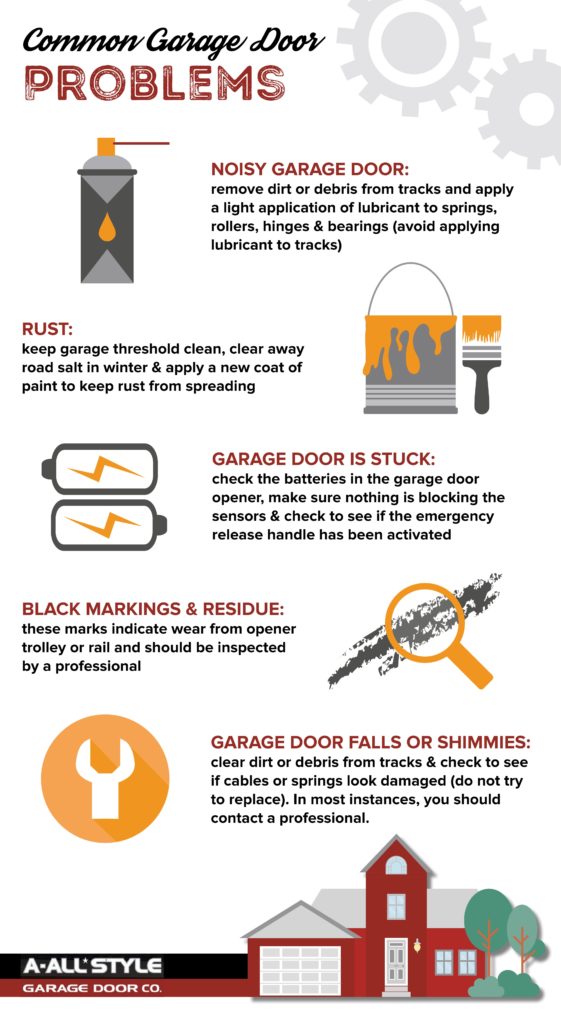
Automatic Garage Doors are popular among homeowners, offering the utmost in convenience, security and weather protection. According to a survey by the U.S. Department of Housing and Urban Development, 66% of American homes feature a garage or a carport, and the vast majority of new homes being built include a garage.
But, for all of their convenience and popularity, every so often a garage door can become a big frustration. With that in mind, we have put together this handy guide to automatic garage door troubleshooting. Checkout our round up of common garage door problems and solutions so you can get back to enjoying the convenience of a functioning automatic garage door.
Common Garage Door Problems
Let’s start with an outline of eight of the most common issues affecting garage doors:
1. Garage door is stuck open or closed.
This may be the most common problem plaguing automatic garage doors. There are a number of reasons why a garage door might have a problem closing or opening. If your garage door won’t open or close, start by troubleshooting common garage door opener problems.
First, make sure the batteries in your garage door opener are fresh. Next, make sure nothing is obstructing the sensors, whether on the actual opener or on the safety sensors that stop the door if something is blocking the threshold.
If these check-ups don’t fix the problem or the issue seems to be spring related, it may be time to call a garage door professional who can safely and quickly diagnose and fix the issue for you.
2. Garage door shimmies as it closes.
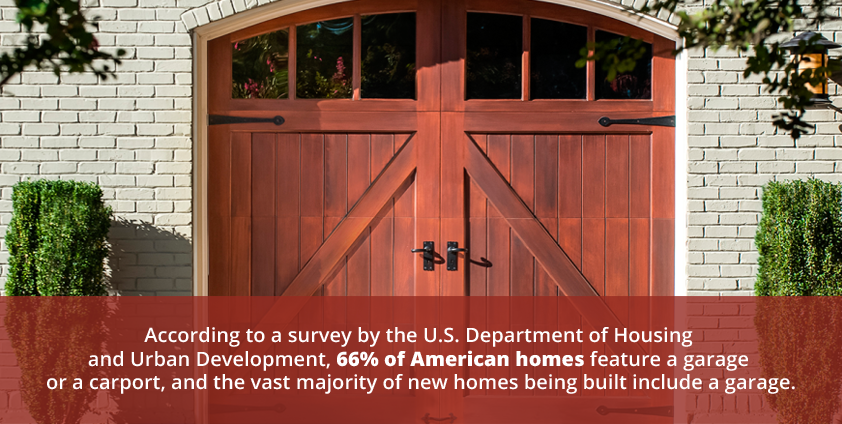
When your door is opening or closing, does it have a noticeable shimmy? While this may be a minor annoyance at first, it will drastically increase wear and tear which can lead to a far more costly repair later.
First, check to see if there are any obstructions on the tracks. If there is any kind of debris on the tracks, you can usually clear the tracks yourself.
Next, check the springs. Do they look damaged? They may need to be replaced, but DO NOT try to replace the springs yourself. Garage door springs are high tension springs, meaning they can cause significant damage or injury if the tension is released improperly.
Finally, if the springs seem to be in order, the issue may be the motor. If there is an issue, the motor may not be opening both sides at the same speed. If this is the case, you will likely need to replace the motor. A garage door professional can identify the exact problem and prescribe the correct course of action if clearing debris doesn’t work.
3. Garage door falls too quickly.
While automatic garage doors are installed with a number of safety measures designed to prevent accidental injuries, sometimes a malfunctioning door can cause a door to become hazardous — such is the case of a door that closes too quickly.
The most likely culprit is either a broken cable or overly loose springs. There isn’t enough tension preventing the door from being pulled down by gravity. The problem is easy to identify. When the door is closed, inspect the cables — but don’t try and make the repairs on your own. Getting the proper tension requires precision, and an improperly installed door can be even more dangerous than the one you are trying to fix.
4. Garage door is loud when opening and closing.
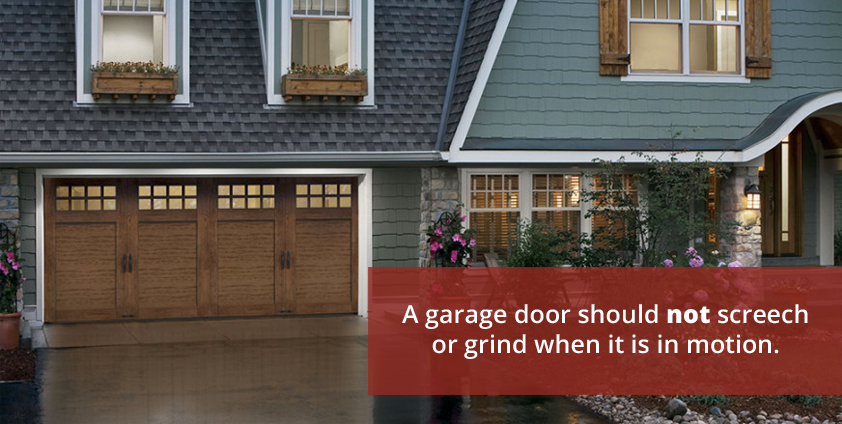
A garage door should not screech or grind when it is in motion. While some noise is unavoidable, a loud garage door is a sign of a problem. The most likely cause is dirt in the tracks. Remove dirt or debris from the tracks, and run the door up and down a few times.
Another option is to apply a light application of lubricant to the springs, rollers, hinges and bearings to help prevent rust and reduce noise. Avoid applying lubricant to the tracks since this may build up and cause issues with your garage door in the future.
If that doesn’t solve the problem, you likely have a poorly hung or severely malfunctioning door and should call a professional to diagnose the problem.
5. Black markings and residue is appearing on the exterior of the door.
Sometimes the exterior of your garage door will begin to show black markings. These markings most likely indicate wear from the opener trolley or rail.
In this case, you may need to have the door adjusted or replaced by a professional.
6. The bottom of the door is showing signs of rust.
This is an especially big problem in the Southwest Suburbs of Chicago. Winter road treatment chemicals and salts can start to erode the paint on your door. You also want to be careful with asphalt seal coatings, as they can also cause damage to your door.
The best solution for halting further rust is to make sure you are keeping your garage threshold clean as best as you can. When winter comes, make sure to clear away any road salt as soon as possible. You will also want to apply a new coat of paint on your door to keep the rust from spreading.
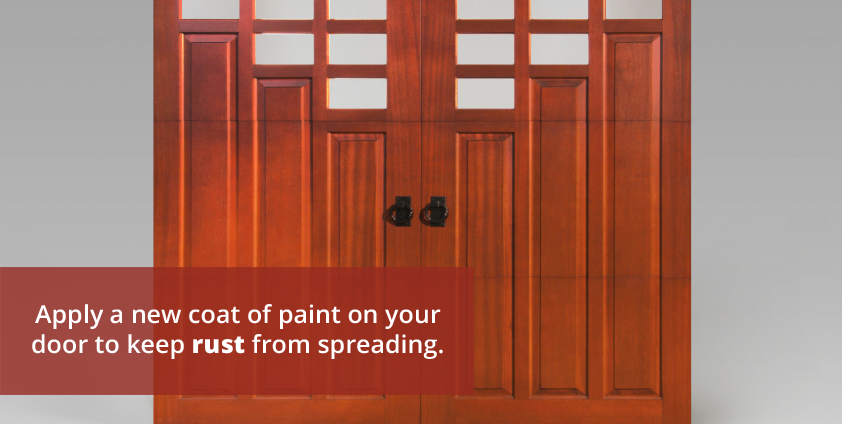
7. Garage door opens and closes randomly.
Nothing is more startling than hearing your garage door open in the middle of the night when everyone is already home. It can be equally disconcerting when you are trying to pull into your garage and your door suddenly closes in front of you.
Unintended door activation can be a symptom of a number of problems. First, ensure your remote isn’t accidentally being pressed. Sometimes a remote gets lodged in a car seat and you don’t realize that it is actually being activated.
There have also been reports that one person’s garage door opener also activates a neighbor’s door as well. If you have a good relationship with your neighbor, ask them to bring their opener over and test it on your door. If the opener works, you will want to change the frequency on either your door or theirs.
However, if neither of those methods of troubleshooting your garage door opener’s problem works, there is likely a communication issue in your automatic opener mechanism and will probably require a replacement installed by a professional.
8. Garage door motor runs but the door doesn’t move.
Have you ever noticed that dangling handle on the garage door motor? It’s connected to a switch that disconnects the door from the motor. It is there so in the event that you lose power, you can still open your garage door by hand.
The most likely reason a garage door motor would run without moving the door is because that switch has been pulled. When the door is either closed or open, make sure the hook that connects the rope to the switch is connected. Then try to activate the door again. If the problem persists, contact a professional to be sure there isn’t a more serious issue.
Extending the Life of Your Garage Door and Preventing Problems Before They Start
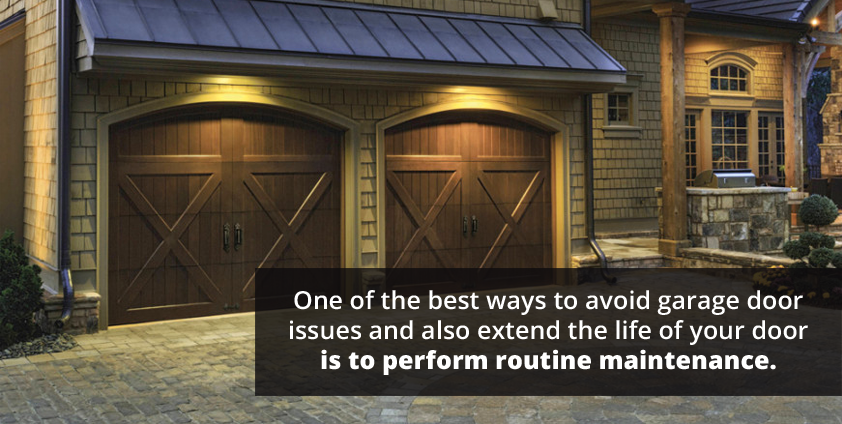
While many of these problems can be caused as much by happenstance as poor maintenance, one of the best ways to avoid garage door issues is to perform routine maintenance. This will extend the life of your door while also helping you avoid far more expensive repairs and replacements in the future.
Here are four things you can do to help ensure your garage door lasts a long time:
1. Start with a visual inspection.
You’d be surprised how many issues can be spotted with a quick visual inspection. The first thing you should do is walk into your garage with the door closed. Do you see gaps or light peeking in through your door? You shouldn’t.
Now, check the cables and springs. Are they loose? They shouldn’t be. Are the hinges rusty? That’s another sign that something is wrong.
Finally, activate the door and listen. If you can hear creaking or scraping, you likely have a problem. All of these issues are signs of a door in need of repair. Luckily, if your door is still working, the repairs are likely minor. If you address minor issues immediately, you will save money in the long run.
2. Check door balance manually.
Remember the pull handle that disconnects the door from the motor? If you want to check the balance, the best way is to disconnect the door, and then try to lift it manually. Start with the door in the closed position and then pull the rope that hangs from the motor.
Because the springs in the door do most of the work, lifting the door by hand shouldn’t be hard. If one side is resisting more than the other, you’ll be able to feel it as you lift. This is a sign your door is unbalanced.
Next, try to pull the door down manually. Again, you should be able to do so easily. However, if the door feels like it is falling, that is evidence your springs are not providing enough resistance.
However, remember, adjusting the springs should ALWAYS be left to a professional. Those springs are high tension springs and can cause severe injury if that tension is released unexpectedly.
3. Clean the safety sensor.
The safety sensor detects if something comes across the threshold of your garage while the door is in motion, halting the door and helping to prevent injury. However, it is important these sensors are kept clean.
Cleaning them is simple, but it should be done regularly. Just use a clean cloth and mild cleanser. It’s especially important to clean the sensor after raking autumn leaves or shoveling a heavy snow — a common occurrence here in the Chicago area.
4. Adding lubrication to hinges of your door.
As noted in our discussion of the common problems plaguing garage doors, proper lubrication is an easy solution to many minor door issues.
Before applying lubrication, use a dry brush to clear away any dirt and debris. Don’t use any solvents as they will interfere with the lubrications.
Once you have cleaned the hinges, apply a quality spray silicone lubricant available at most hardware stores and home centers. It is important to use the proper type of lubricant, as some may gum up your garage door, which defeats the purpose. Also, avoid liquid lubricants, as they are easily over-applied, which again will cause more problems.
If you aren’t sure about how to lubricate your door properly, don’t be afraid to contact a professional. They will know exactly how to advise you or perform the necessary application.
Keep Your Garage Door Running Smoothly With A-All StyleGarage Door’s Troubleshooting Guides.
- Garage Door or Opener Installation: DIY vs. Professional
- How LED Lights Cause Interference With Your Garage Door Opener
- Maintenance Tips For Wood Garage Doors
- Troubleshoot Programming A Garage Door Opener For Your Car
- Troubleshooting Garage Door Sensors
Contacting a Professional
While there are many things you can do yourself to keep your garage door in optimal working order, sometimes things are best left to a professional.
Luckily, here in the Naperville, Bolingbrook, Plainfield and surrounding areas in the Southwest Suburbs of Chicago, you have access to some of the most experienced and friendliest garage door professionals around.
At A-All Style Garage Door, we have been family owned since 1981. We pride ourselves in providing top-grade garage door installations and repairs, and we stand behind our work. We offer a number of innovative and cost-effective garage door designs, and we have the experience to make sure they are installed correctly — thus ensuring they are long lasting and will save you money in the long run.
So if you have more questions concerning your garage door, its maintenance or whether it is time to replace an old door, don’t hesitate to contact us. Also check out our ask the door guy page for more tips and advice for frequently asked garage door repair and maintenance questions.
